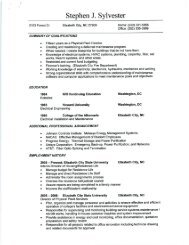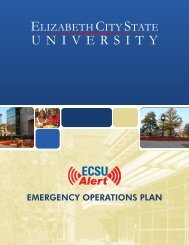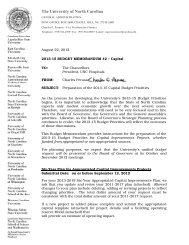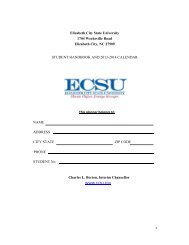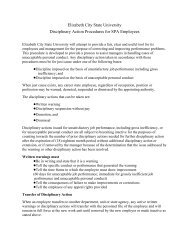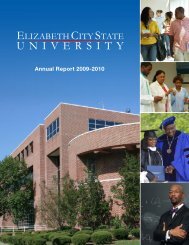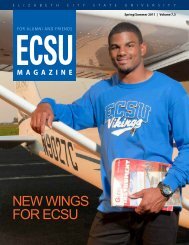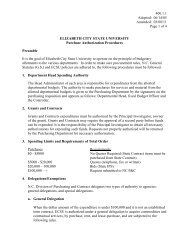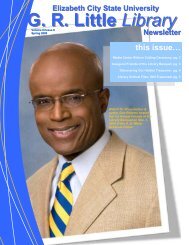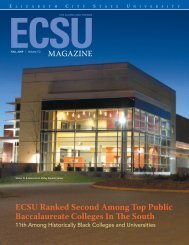ECSU Magazine 2.1.pmd - Elizabeth City State University
ECSU Magazine 2.1.pmd - Elizabeth City State University
ECSU Magazine 2.1.pmd - Elizabeth City State University
Create successful ePaper yourself
Turn your PDF publications into a flip-book with our unique Google optimized e-Paper software.
CERSER facility places <strong>ECSU</strong>among elite marine facilitiesChancellor Mickey Burnim andMike Crowley, of SeaSpaceCorporation, sign theMemorandums of Understandingmaking the university andSeaSpace partners in remotesensing research. SeaSpace is aninternational leader in remotesensing technology and theworld’s leading weatherinformation provider.<strong>Elizabeth</strong> <strong>City</strong> <strong>State</strong> <strong>University</strong> recently opened its new Center ofExcellence in Remote Sensing Education and Research (CERSER), afacility that scientists say will drastically improve the way we learnabout changes along coastlines and in oceans.The goal of the Dixon Hall facility is to develop innovative andrelevant research collaboration focused on coastal, ocean andmarine research. Remote sensing is a means of acquiringinformation about the earth’s surface without actual contact withthe elements. <strong>ECSU</strong> students and faculty researchers use satellitedata, computers and other devices to sense and record reflected oremitted energy. The researchers then analyze and apply theinformation to various research projects.CERSER is especially important to North Carolina and Virginiaresidents because it will provide an abundance of information onthe changes in atmosphere that lead to high winds, rain, tropicalstorms and hurricanes long associated with coastal communities.Through the center’s sophisticated equipment, <strong>ECSU</strong> scientists andstudents can track weather patterns, document changes inwaterways and the impact those changes have on the organismsliving there.Dr. Linda Hayden, Director of CERSER at<strong>ECSU</strong>, is confident this new research centerwill enhance studies underway in the DismalSwamp and along the North Carolinacoastline. She sees CERSER as a key tool in<strong>ECSU</strong>’s ability to attract new studentsinterested in marine science. The center is alsoan educational tool that will prepare studentsfor graduate school in related fields of study.To kickoff the new center last spring,Dr. Hayden hosted the first IEEE Geoscienceand Remote Sensing Distinguished SpeakerLecture. Guests came from governmentresearch facilities, private companies,professional/academic research organizationsand universities. All came with a centralinterest — discussing how remote sensing labshelp scientists increase their knowledge ofchanges occurring in oceans, along coastlinesand on land.Charles Luther, president of the IEEEGeoscience and Remote Sensing Society,credits <strong>ECSU</strong> with being the only historicallyblack college/university on the east coast tohave a remote sensing satellite data receivingstation. Luther predicts CERSER will prove agreat opportunity for more young minorityresearchers to enter fields of study where theyhave traditionally been underrepresented. Chancellor Mickey L. Burnimsigns the Memorandums ofUnderstanding with Dr. MohamedMohamed, of Pixoneer Geomatics,and becomes partners withPixoneer, a premier provider ofimage processing software andremote sensing services for theeducation, government, military,and commercial sectors.featuresFrom left, Charles A. Luther, of the IEEE Geoscience and Remote SensingSociety, Dr. Sonia Gallegos of the Naval Research Laboratory at StennisSpace Center, Dr. Linda Hayden and James Harrington, of Minority <strong>University</strong>-Space Interdisciplinary Network, celebrate the grand opening of the CERSERfacility. Dr. Hayden welcomed these guests to campus for presentations onremote sensing and student development in academic research.6 <strong>ECSU</strong> MAGAZINE FALL 2003




